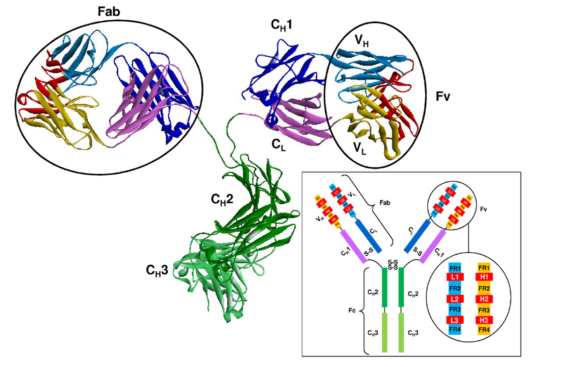Antibody-Antigen Recognition
Antibody engineering has long been a hot research area in protein engineering. The function of antibodies (Abs) involves specific binding to antigens (Ags) and activation of other components of the immune system to combat pathogens. It is now generally accepted that the six hypervariable loops within the Abs variable domain, the commonly mentioned complementarity determining regions (CDRs), are responsible for the recognition of Ag, while the constant domains are thought to mediate the activation of effectors. Creative Biolabs provides customers with antibody-antigen recognition services to help customers advance the process of Ab development.
Antibody-antigen Interaction
An antigen-antibody interaction or antigen-antibody reaction is a specific chemical interaction between antibodies produced by B cells of a leukocyte and an antigen during an immune response. It is a basic reaction in the body that protects the body from complex foreign molecules such as pathogens and their chemical toxins. The association between Ab and Ag involves numerous non-covalent interactions between the binding site of the Ag epitope and the complementary site on the Ab. The ability of Abs to bind virtually any non-self surface with exquisite specificity and high affinity is not only the key to immunity but has also made Abs an enormously valuable tool in experimental biology, biomedical research, diagnostics and therapy.
Although many antibodies have been studied for decades and their structures and functions have been characterized, in fact, we still know very little about their interaction with antigens. The best way to understand the antigen-antibody interaction is to obtain a three-dimensional structure model of their binding, which is generally achieved by X-ray crystallography. However, this method has a long experimental period and cannot obtain stable results. Now, thanks to advances in algorithms and processing power, we can apply computational techniques to the structural characterization of intermolecular complexes. Computational docking refers to the process of predicting the conformation of a complex starting from the separated components of the complex. It provides a fast and inexpensive way to obtain structures, including structures that are not suitable for experimental determination. In addition, the contribution of Ab's non-CDR portion, framework region (FR), and constant domain to Ag binding was also considered in the antibody recognition assay.
 Fig.1 The structure of an Ab molecule. Distributed under CC BY-SA 4.0, from Wiki, without modification.
Fig.1 The structure of an Ab molecule. Distributed under CC BY-SA 4.0, from Wiki, without modification.
Antibody-antigen Recognition
The primary focus of analyzing the structural basis of Ag recognition is to determine the exact boundaries of the CDRs in a given Ab. It is common practice to identify the paratope by identification of the CDRs. However, some studies in recent years have shown that not all positions in the CDRs traditionally defined are important for binding, and some positions that play a key role in binding are located outside of the transition CDR. Creative Biolabs detects its relationship to the Ag interface by predicting the entire Ab structure.
We provide a docking method for antibody Ab recognition antigen Ag, based on Rosetta's calculation protocol, used to predict the three-dimensional structure of the antibody from the sequence, and then dock the antibody to the protein antigen . Antibody modeling uses standardized loop conformations to transplant large fragments from experimentally determined structures and performs energy calculations to minimize loops. Our docking method improves the relative orientation of VL-VH and can predict difficult-to-determined CDR H3 loops from scratch. To mitigate model uncertainty, antibody-antigen docking resamples the CDR loop conformation, and multiple models can be used to represent the conformational set of antibodies, antigens, or both.
We can provide different docking methods. In addition, we can optimize the results of docking through molecular dynamics (MD) to obtain high-precision recognition models.
If you have any questions about our protein engineering service, you can contact us by email or send us an inquiry to find a complete solution.
For Research Use Only.
